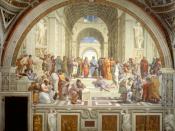The word Renaissance originally came from the French version of the Italian word rinascita which means rebirth. The Renaissance was characterized by geographical exploration, the growth of secular values, and scientific and artistic inquiry. The Renaissance was also a cultural and intellectual movement where many advancements were made in the fields of music, literature, art, and science. During the 15th century students flocked to Italy from all of Europe to study philosophy, the classics, and the remains of antiquity. Italian literature and art, even clothing and furniture designs, were imitated in the rest of western and northern Europe. The later Renaissance was marked by the growth of bureaucracy and the creation of larger regional states. The Renaissance spawned some of the greatest thinkers and creators of all time.
In noble families infants were typically nursed by wet nurses. Physicians did not recommend this, but it was socially popular at the time because it gave women more freedom in between frequent pregnancies.
Children were then sent to boarding schools to learn social decorum and correct behavior. Many girls married very young for reasons of property and family alliance. When a girl reached marriageable age, her change in status was recognized in one or more ceremonies. On the night of April 30th a maypole was erected in front of the house of any such girl. If the girls manners or behaviors were considered scandalous, males of the town left defamatory items in front of her house. Marriage was a very important institution during the Renaissance. It was a religious, economic, and practical necessity. It was a major means of increasing a family's capital. The virginity of the bride was of paramount importance. Besides that, all of her qualities were judged. Women were excluded from public office and responsibilities outside of the home.


